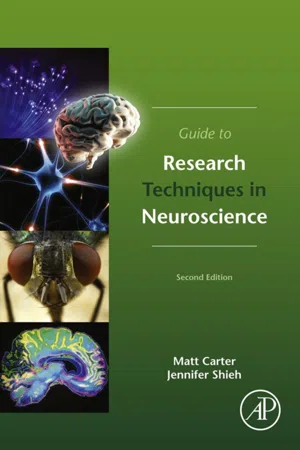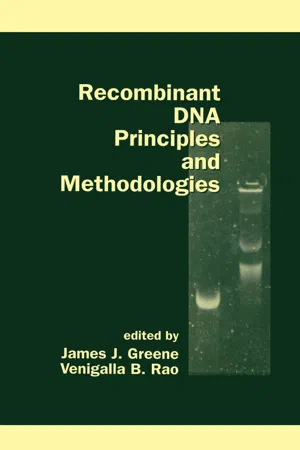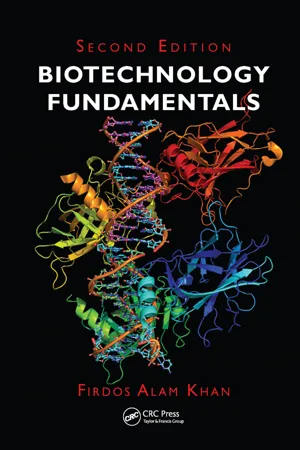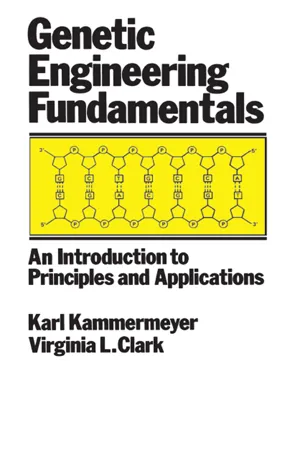DNA Cloning
DNA cloning is a process used to make multiple copies of a specific DNA sequence. It involves inserting the DNA fragment of interest into a vector, such as a plasmid, and then introducing this recombinant DNA into a host organism, typically a bacterium. The host organism replicates the recombinant DNA, producing numerous copies of the inserted DNA fragment.
7 Key excerpts on "DNA Cloning"
- eBook - ePub
- Matt Carter, Jennifer C. Shieh(Authors)
- 2015(Publication Date)
- Academic Press(Publisher)
...The essential features of a vector are that it can replicate autonomously in a host species, usually bacteria, and that it can be combined with other pieces of DNA. Often, the inserted DNA fragment comes from a different organism than the vector DNA, and the fusion is called a recombinant DNA construct. Two commonly used vectors are plasmids, naturally occurring circles of DNA that act as independently replicating accessory chromosomes in bacteria, and bacteriophage or phage, a virus that can deliver its genetic cargo to bacteria. It is much more common for scientists performing recombinant DNA techniques in the laboratory to use plasmids over phage vectors. Many plasmids have been ingeniously modified to enhance the delivery of recombinant DNA molecules into bacteria and to facilitate the selection of bacteria harboring these vectors. BOX 10.2 The Definition of Clone The word clone is used often in molecular biology. Unfortunately, this word has distinct definitions that can often cause confusion. In general, the precise definition of a clone is an exact copy. In reference to a piece of DNA, this term implies that a scientist will make exact copies of a DNA sequence. In reference to a bacterial cell, this term implies that a bacterium will multiply to eventually produce millions of genetically identical bacteria, each harboring the same DNA as the initial cell. Nowadays, it is possible to produce clones of larger organisms, including mammals—meaning that the animals share identical copies of genomic DNA. The term “cloning a gene” usually refers to the process of isolating a particular DNA sequence, placing the sequence in a vector, and producing many copies of the vector for use in subsequent experiments...
- eBook - ePub
- James Greene, James Greene(Authors)
- 2021(Publication Date)
- CRC Press(Publisher)
...Gene cloning is usually performed by ligation of DNA fragments to a vector molecule, transformation of the recombinant molecule into the host strain, and detection of the clones containing the recombinant DNA molecules or their gene product in the host organism. Recombinant DNA can be further manipulated and edited to fulfill diverse interests. Figure 2 shows a diagramatic representation of alternative cloning procedures, whereas Table 1 shows a comprehensive listing of the steps and options for a DNA Cloning experiment. The foundations of such methods will be briefly discussed. Figure 2 General scheme of a cloning experiment using plasmid DNA as a vector. Careful analysis of the DNA fragment to be cloned and the available plasmids is the key step in planning a cloning experiment. Both DNAs should be isolated and prepared accordingly, mixed, and either ligated prior to transformation or introduced into E. coli for in vivo ligation (in this case the molecules should be aligned by hydrogen bonding of complementary DNA nucleotides). After transformation, cells carrying the recombinant DNA have to be separated from the ones carrying only the vector or no plasmid DNA by a selection scheme usually provided by the plasmid...
- eBook - ePub
Essentials of Chemical Biology
Structure and Dynamics of Biological Macromolecules
- Andrew D. Miller, Julian A. Tanner(Authors)
- 2013(Publication Date)
- Wiley(Publisher)
...This collection of DNA molecules is known as a cDNA library. In the final stage of preparation before use, adapter DNA sequences are ligated onto both ends of each DNA/DNA duplex, with the assistance of a DNA ligase enzyme. These adapters contain essential sequence elements for the conversion of every DNA/DNA duplex of the cDNA library into a genomic component that can be integrated with the paraphernalia of recombinant techniques into the complete tool-kit of genomic components associated with molecular biology (see Subections 3.2.2 and 3.2.3). 3.2 Tools and techniques in molecular biology The key to manipulation in molecular biology is the isolation, cloning and identification of genomic information in an appropriately useful DNA form. From this all else flows (see Section 3.1). What are the main tools and techniques available? 3.2.1 Plasmid DNA vectors The plasmid is central to almost all molecular biology manipulations of genomic DNA or cDNA. The term plasmid refers to DNA that is able to replicate independently of chromosomal DNA. Plasmid DNA (pDNA) systems were first found in prokaryotes and were quickly realised to be ideal potential vectors (Figure 3.5). A vector is an autonomous DNA construct suitable for recombination with heterologous DNA, from genomic DNA or cDNA library sources, to form recombinant pDNA constructs for the purposes of cloning and/or heterologous gene expression. A vector based on pDNA should have an origin of replication together with one or more selectable markers. An origin of replication is a non-coding DNA sequence that defines the position from which pDNA replication commences when appropriate. Selectable markers are genes that code for a selectable trait such as antibiotic resistance. Vectors are divisible into two main types, cloning vectors and expression vectors, of which the latter can be used to direct expression in vivo of a desired protein or non-coding RNA (see Sections 3.3.1 and 3.3.3)...
- eBook - ePub
- Firdos Alam Khan(Author)
- 2020(Publication Date)
- CRC Press(Publisher)
...Scientists believe that reliable cloning can be used to make farming more productive by replicating the best animals and crops and to make medical testing more accurate by providing test animals that all react the same way to the same drug. PCR is a revolutionary technology and is more efficient than gene cloning as it needs much less of the desired DNA (a single copy is enough). It is not difficult to store and does not require costly restriction enzymes, ligase, and vector DNA, thus drastically reducing the experimental cost. It needs far less work, time, and skill, and has many more applications than gene cloning. Typically, gene cloning experiments take 2–4 days, whereas PCR takes only up to 4–5 h. In addition, PCR is fully automated but gene cloning is not. Nevertheless, for PCR, one does need sequence information for construction of primers and a thermal cycler or PCR machine. It is expected that PCR will eventually take over most of the applications of gene cloning and will find many novel applications as well. 4.7 SIGNIFICANCE OF VECTORS IN RECOMBINANT DNA TECHNOLOGY Recall that in molecular biology, a vector is a DNA molecule used as a vehicle to transfer foreign genetic material into another cell. Viral vectors are tools commonly used by molecular biologists to deliver genetic material into cells. This process can be performed inside a living organism (in vivo) or in a cell culture (in vitro). Viruses have evolved specialized molecular mechanisms to efficiently transport their genomes inside the cells they infect. Delivery of genes by a virus is termed transduction and the infected cells are called transduced. Molecular biologists first harnessed this machinery in the 1970s. Paul Berg used a modified SV40 virus containing DNA from the bacteriophage lambda to infect monkey kidney cells maintained in culture. The four major types of vectors are plasmids, bacteriophages and other viruses, cosmids, and artificial chromosomes...
- eBook - ePub
From Genes to Genomes
Concepts and Applications of DNA Technology
- Jeremy W. Dale, Malcolm von Schantz, Nicholas Plant(Authors)
- 2011(Publication Date)
- Wiley(Publisher)
...2 How to Clone a Gene 2.1 What is cloning? Cloning is defined as the use of asexual reproduction to obtain organisms that are genetically identical to one another, and to the ‘parent’. This contrasts with sexual reproduction, where the offspring are not usually genetically identical. It is worth stressing that clones are only identical genetically ; the actual appearance and behaviour of the clones will be influenced by other factors such as their environment. This applies to all organisms, from bacteria to humans. Despite the emotive language surrounding the word ‘cloning’, this is a surprisingly familiar concept. In particular, anyone with an interest in gardening will know that it is possible to propagate plants by taking cuttings. These are clones. Similarly, the routine bacteriological procedure of purifying a bacterial strain by picking a single colony for inoculating a series of fresh cultures is also a form of cloning. The term cloning is applied to genes, by extension of the concept. If you introduce a foreign gene into a bacterium, or into any other type of cell, in such a way that it will be copied when the cell replicates, then you will produce a large number of cells all with identical copies of that piece of DNA – you have cloned the gene (Figure 2.1). By producing numerous copies in this way, you can sequence it or label it as a probe to study its expression in the organism it came from. You can express its protein product in bacterial or eukaryotic cells. You can mutate it and study what difference that mutation makes to the properties of the gene, its protein product, or the cell that carries it. You can even purify the gene from the bacterial clone and inject it into a mouse egg, and produce a line of transgenic mice that express it...
- eBook - ePub
- Firdos Alam Khan(Author)
- 2018(Publication Date)
- CRC Press(Publisher)
...That DNA is then introduced into a host organism cell, where it grows with the organism. 4.7.1.3 What are the differences between PCR and cloning? PCR has become a standard tool in forensic science because it can multiply very small samples of DNA for multiple crime lab testing. PCR has also become useful for archaeologists to study the evolutionary biology of different animal species, including samples thousands of years old. Cloning technology has made it relatively easy to isolate DNA fragments that contain genes to study gene function. Scientists believe that reliable cloning can be used to make farming more productive by replicating the best animals and crops and also to make medical testing more accurate by providing test animals that all react the same way to the same drug. PCR is a revolutionary technology and is more efficient than gene cloning, as it needs much less amount of the desired DNA (a single copy is enough). It is not difficult to store and does not require costly restriction enzymes, ligase, and vector DNA, thus reducing experimental cost drastically. It needs far less work, time, and skill and has many more applications than gene cloning. Typically, gene cloning experiments take 2–4 days, while PCR takes only up to 4–5 h. In addition, PCR is fully automated, while gene cloning is not. Nevertheless, for PCR, one does need sequence information for construction of primers and a thermal cycler or PCR machine. It is expected that PCR will eventually take over most of the applications of gene cloning and will find many novel applications as well. 4.8 Significance of vectors in recombinant DNA technology Recall that in molecular biology, a vector is a DNA molecule used as a vehicle to transfer foreign genetic material into another cell. Viral vectors are tools commonly used by molecular biologists to deliver genetic material into cells. This process can be performed inside a living organism (in vivo) or in cell culture (in vitro)...
- eBook - ePub
Genetic Engineering Fundamentals
An Introduction to Principles and Applications
- John Kammermeyer(Author)
- 2017(Publication Date)
- CRC Press(Publisher)
...The engineered vectors are then inserted into a microbial host which recognizes the vector’s replicon. From here on the cloning procedure begins, that is the formation of new microbial entities which are identical to the original structure. Some foreign DNA fragments of course, can contain replicons which may be recognized by the host. THE CLONING PROCESS Gene Introduction. The insertion of a specific DNA sequence into a vector, that is, the carrier of the new gene, requires the following conditions (6): 1. A DNA vehicle (vector or replicon) which can replicate after foreign DNA is inserted in it. 2. A DNA molecule to be replicated: the foreign DNA insert, the passenger. 3. A method for introducing a passenger into the vehicle. 4. A means for introducing the vehicle carrying the passenger into a host organism in which it can replicate; DNA transformation or transfection (the term transfection is used frequently with viral DNA). 5. A means for screening or genetic selection for those cells that have replicated the desired recombinant molecules. This screening or selection process provides a way to recover the specific recombinant DNA in pure form. (The screening process by means of antibiotic resistances was illustrated in Figure 3.) Elaboration: 1. Cloning vehicles. Frequently used vehicles are bacterial plasmids from E. coli and B. subtilis ; also used are yeast, streptomyces, bacteriophage λ, phage M13, and SV40 virus. 2. DNA to be replicated. DNA fragments having the desired genome can be prepared by mechanical chopping (nonspecific fragments) or by digestion with restriction endonuclease (specific site cleavage). For a particular gene selection, the fragmented DNA is separated by means of gel electrophoresis (e.g., agarose gel). The fractions of the desired size are excised from the gel slab and eluted. Chemical synthesis of short segments (~ 40 bp) of oligodeoxynucleotides has been developed...






